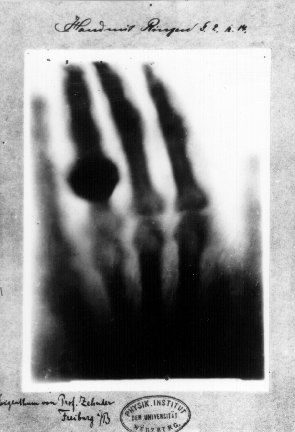- C
- A
- B
- A
Wilhelm Roentgen
Wilhelm Roentgen, the German physicist who discovered the x-rays and paved the way to radiation treatment and modern x-rays.
Sunday, September 1, 2013
Questions
1) Why was Roentgen expelled from school?
a) misconduct
b) bad grades
c) falsely accused
b) bad grades
c) falsely accused
2) Why didn't Roentgen first publish his findings?
a) feared his colleges would mock him
b) felt his findings were not important
c) feared he couldn't back up his discovery
3) What was the first x-ray of?
a) his wife, Anna's right hand
b) his wife, Anna's left hand
c) his wife, Anna's left foot
4) In 1901, what happened?
a) awarded the first Nobel prize for physics
b) discovered x-rays
c) awarded a Ph.D
Thursday, August 29, 2013
Thank You
This is Wilhelm Roentgen, the guy opened eyes in the medical field. He is the main reason we have the x-ray and modern radiation.
Thank you for watching my presentation.
After Discovery
- Wilhelm won a honorary Doctorate in medicine after his findings were made public by The University of Wurzburg
- In 1901 he was awarded the first Nobel Prize for physics
- He gave the money from the Nobel prize to his University
- Wilhelm Roentgen died at Munich on February 10, 1923, from Carcinoma of the intestine.
First X-ray

The first x-ray was of his wife, Anna. It was of her left hand, complete with wedding ring. This picture became very famous and the discovery was greeted with great enthusiasm
X-rays
- He called the strange rays, X-rays because 'x' is the mathematical term for 'unknown'
- People wanted to honor Roentgen and call the rays Roentgen rays, but Roentgen preferred x-rays and the term stuck
- At first he did not publish his findings till later, believing his colleges would mock his findings
- He also did not want to patent his discovery
The Discovery
- 1895 carried out his investigations on the phenomenon of cathode rays
- Roentgen took a vacuum tube, that he used for cathode ray experiments and covered it in thin black cardboard and placed it in a darkened room.
- A bright glow was seen on a screen covered with florescent lights.
- He realized that the florescent was caused by an agent which could infiltrate from within the vacuum tube through the black cardboard.
- He called the agent X-rays
Factors that led to the Discovery
Wilhelm Roentgen accidentally put a piece of card board covered with florescent mineral near the experiment and noticed it glowing in the dark. Roentgen decided to investigate further.
Influence
- Because of his discovery of the x-rays, we now have a vast knowledge of bone structure and many other things.
- One of the origins for the Scientific Revolution.
- Helped and opened eyes for science, biology, and physics.
Wednesday, August 28, 2013
Impact
- You can now see the bone, lungs and other organs throughout the body
- The birth of modern radiation and x-rays
- Impacted the technology and things we use today in the hospital
Early Life cont.
- Roentgen passed the exams and studied medical engineering at the Federal Polytechnic Institute
- He was awarded a Ph. D in 1869
- 1876-1900 Roentgen held a good number of professorships and department chairs
- He wished to move to america but WW1 stopped those dreams so he stayed in Munich, where he lived the rest of his life.
Early Life
- Wilhelm Roentgen was born March 27th 1845 in Rhenish, Prussia.
- When he was young his parents moved to the Netherlands.
- He received his education from a boarding school in Utrecht
- He was expelled from the school and banned from similar schools around that area.
- He was accused of drawing a caricature of one of the teachers which was drawn by someone else.
- Roentgen was NOT able to attend a college in Germany or the Netherlands.
- He had to apply for one in Zurich, in which he had to pass multiple exams.
Resources
Just to start off there are many ways to spell Wilhelm Roentgens name. The easiest and the most common from the sources that I used was 'Roentgen'
The sources that I used were
Subscribe to:
Comments (Atom)

